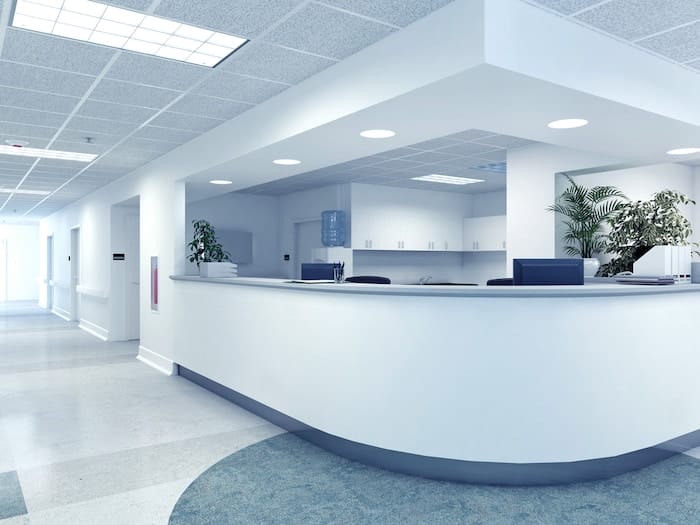Consider this. The average American visits the doctor at least four times a year. Whether you’re going for your annual check-up or you require urgent care, the healthcare facility you select is one of the most important decisions you can make for your well-being.
Nowadays, there are more provider choices than ever before, and healthcare administrators are feeling the pressure to stand out in this crowded marketplace. It’s never been a better time to use one of your most basic assets – your facility’s lighting – to claim the spotlight.
Previously, facility lighting was limited to illumination, but it has evolved to be much more than an on/off function with the introduction of the Internet of Things (IoT). It has the potential to enrich yourpatient experience and support your healthcare business goals at the same time. Here are three ways how:
Design a ‘Connected’ Experience to Reinforce Patient-Centric Care
Meeting patient expectations is a tall order, especially as more and more want seamless and efficient experiences. But their satisfaction is paramount to your success. It’s no longer enough to simply provide professional services to your patients. Instead, your building environment must be designed to help nurture, heal and inspire well-being.
With connected lighting, you can help achieve this. For example, to alleviate the tension and stress of a doctor’s visit, healthcare administrators can schedule custom light scenes to support patient comfort or allow them to select their own scene via a master switch on the wall. In essence, you put the patient in the driver’s seat, setting their room’s light levels and color temperatures to their preference.
The connected lighting system can even be synced with the time of day to support the patient’s natural day-night, or circadian, rhythm, which dictates the biological clock for living beings and their energy levels. Several studies have noted the positive outcomes that this type of light exposure can have, such as reducing depression, decreasing fatigue and improving alertness.
Make an Impact on Your Bottom Line with Energy Savings
It’s no surprise that the healthcare system contributes to 10% of the United States’ carbon emissions given how energy intensive most facilities are. Basic utilities like heating, lighting and hot water are essential, but consume roughly between 230 to 330 kilowatt hours/square meters annually. Taking a new approach with connected lighting can help you reduce operational costs and increase energy savings by up to 75%, so you can focus your resources on where it’s needed most: your patients.
To maximize energy savings, consider integrating a connected lighting system with your existing Property Management System (PMS) to share data across your applications. From sensors embedded into the lights, you can monitor the occupancy of a room to adjust the HVAC settings accordingly. When a room is vacant, it turns off the lights and switches the temperature to energy-saving mode. Similarly, it will toggle back to default light levels and heating/cooling settings upon motion detection. This is especially useful in your back-of-house operations, like laundry rooms and storage spaces, and other areas with inconsistent footfall, like cafeterias. You can pick up additional savings with daylight sensing, which automatically lowers light levels to compensate for extra daylight seeping in through windows. Together, these functions enable you to only use energy when and where it is needed – maximizing savings.
You can also get a richer picture of your facility. In your system’s dashboard, you can visualize and track your energy usage across an entire campus, building or go room-by-room for more granular insights. At-a-glance historical data can identify how your operational patterns stack up with your energy reduction goals, which can be used to drive future improvements.
Prioritize Employee Wellness to Help Your Business Flourish
Meeting your patients’ needs is of the utmost importance, but what about your staff? They are critical to your business. Connected lighting can be a real game changer when it comes to supporting employees’ well-being and productivity.
Many healthcare environments operate 24 hours a day, seven days a week. While this is convenient for patients, it results in non-traditional work hours for your staff, which can displace their circadian rhythms. Much like patients, bio-adaptive light can benefit your employees. Begin a shift with a crisp, bright tone of white light for an energy boost and to promote concentration. Then, scale down the lighting to warmer tones and help them transition to a restful, relaxed state as their shift ends.
These systems can also be used to boost staff productivity, for example, through location-based services and applications. At a moment’s notice, your employees need to use a variety of medical equipment, but it can be difficult to keep track of these items. Your lighting, combined with the smart sensors, can help pinpoint where medical devices and other assets are and guide your employees to them. This allows your staff to spend less time searching through your building, enabling them to deliver care more efficiently.
Healthcare administrators can even integrate their connected lighting system with nurse call centers to further enhance quality of care. In the dashboard, nurses can view room statuses, which are especially helpful for avoiding double booking a room. It can display more general patient requests, like bathroom assistance or food service, as well.
See Well, Feel Well and Perform Well
Our healthcare system is transforming, and so must our facilities. Making the switch to connected lighting is a simple but significant way healthcare administrators can deliver new experiences for patients and staff and lay the foundation for a smarter, brighter future for the business.

Rahul Shira
Rahul Shira is Senior Product Marketing Manager for Signify.







